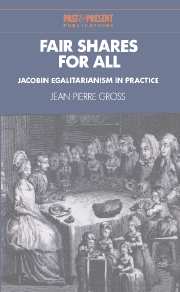Book contents
- Frontmatter
- Contents
- List of tables
- Acknowledgements
- The revolutionary calendar
- List of abbreviations
- Introduction
- 1 The Jacobin mainstream and the Robespierrist ascendancy
- 2 The family ethos and the common happiness
- 3 Food rationing, collectivism and the market economy
- 4 Land tenure, shelter and the right of ownership
- 5 Progressive taxation and the fair distribution of wealth
- 6 Jobs for all and to each a fair deal
- 7 A place at school and a time for rejoicing
- Conclusion
- Bibliography
- Index
- Past and Present Publications
2 - The family ethos and the common happiness
Published online by Cambridge University Press: 22 September 2009
- Frontmatter
- Contents
- List of tables
- Acknowledgements
- The revolutionary calendar
- List of abbreviations
- Introduction
- 1 The Jacobin mainstream and the Robespierrist ascendancy
- 2 The family ethos and the common happiness
- 3 Food rationing, collectivism and the market economy
- 4 Land tenure, shelter and the right of ownership
- 5 Progressive taxation and the fair distribution of wealth
- 6 Jobs for all and to each a fair deal
- 7 A place at school and a time for rejoicing
- Conclusion
- Bibliography
- Index
- Past and Present Publications
Summary
Every evening, at supper, which was the only meal when all the family could be assembled, he would find himself, like a venerable patriarch, at the head of a numerous household; for we were normally twenty-two at table, including the ploughboys and the vine-tenders, who in winter were threshers, the cowherd, the shepherd and two dairymaids.
Restif de la Bretonne, La vie de mon père, 1778THE RIGHTS OF MAN: FROM 1789 TO 1793
The reference to the rights of man is a constant feature of revolutionary egalitarianism and helps underscore its continuity. The abolition of privileges, which introduced civic and political equality into the revolutionary process on the night of 4 August 1789 and heralded the advent of greater material equality, clearly occupied the minds of those who set about drafting the Declaration of Rights that same month. The fact that the Declaration itself gives prominence to the individual liberties enshrined in previous English and American bills of rights should not detract from the recognition that it contains a number of significant egalitarian safeguards as well, and that a basic difference in conception lends it a strong political and economic bias.
- Type
- Chapter
- Information
- Fair Shares for AllJacobin Egalitarianism in Practice, pp. 41 - 63Publisher: Cambridge University PressPrint publication year: 1996

